19.08.15
Active by design: creating healthy places
Source: PSE - Aug/Sep 15
PSE’s Luana Salles investigates the aims and progress of a new programme championing the creation of ‘healthy places’.
In 35 years, three in every five British men will be obese. Half of the women you know will follow suit. The mere prospect is a bitter pill to swallow – and to never exercise off – but the present is always here to snap nonbelievers back to reality.
In fact, current figures are extremely telling of the imminent pandemic: a quarter of adults now walk for less than nine minutes before they call it a day, and only 21% of their children are encouraged to play outdoors. It comes as no surprise, then, that nearly half of long-term health conditions are caused by being physically inactive.
In some parts of the country, these figures are more expressive than ever: derelict parks, unsafe streets and monoculture-ridden suburbs consistently fail to stimulate residents to go for a walk, cycle to shops or even interact with their neighbours.
Rectifying the mistakes of the past
West Howe is an archetypal example of poor urban design, with a compendium of factors conspiring to keep people who live there in poorer health. Formerly a stopping place for Travellers, the Bournemouth estate was gradually developed for housing by the council in the 1950s. Councillors planned their design around the motorcar – all the rage at the time – and based the layout of semi-detached houses on the American suburbs.
In doing so, town planners ripped the heart right out of West Howe: a ‘town centre’ is unheard of, residents vaguely know where the corner shop is, and even the doctor’s surgery lies lost and empty in the middle of a field.
The prevalence of so-called ‘monoculture’ in the scattered estate was ripe for anti-social behaviour, obesity and loneliness, skewing already worrying health statistics even further. Locals are more likely to be obese and to not have exercised at all in the past year than the average person, are three to seven times more likely to be heavy smokers, and will probably die almost four years earlier than the rest of the nation.
Intelligent urban planning
Bournemouth Borough Council knew this situation couldn’t go on, and commissioned experts from the Design Council who have recently created a programme to inspire exactly this: health and wellbeing through intelligent urban planning.
Active by Design, headed by Rachel Toms, is the Design Council’s latest project, crafted as a response to the soaring social and economic costs of preventable diseases in the country. Professionals are handpicked to help clients create places in which being active is an integral part of everyday life.
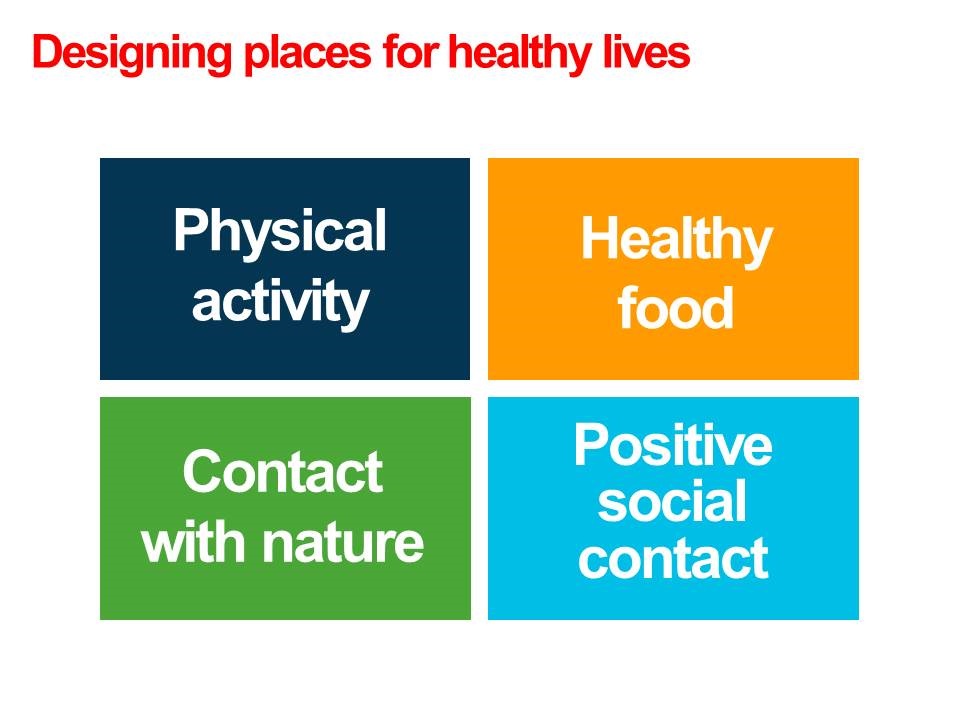
The 36 experts in their vast catalogue – each with diverse professional backgrounds comprising architecture, urban design, landscape design and transport – are keen on training locals on how to identify issues in each chunk of the public sector, including schools, houses, open spaces, and transport. Every commissioned professional works with four determining targets in mind: encouraging physical activity, healthy diets, contact with nature and positive social contact.
Fact-finding
West Howe effectively brought Active by Design to life – it was the scheme’s first client under that specific name, though other Design Council projects also had a focus on ‘healthy placemaking’.
Experts from the programme were commissioned by councillors to help bring together a variety of public sector figureheads under one umbrella – quite literally (see picture, below). They were determined to survey the entire estate, and so divided it into manageable sections to identify what could be improved – from public buildings and houses to parks and streets.
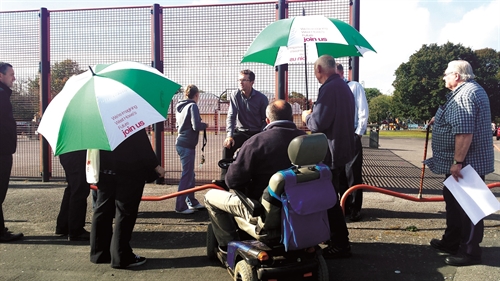
Together with a dozen community ambassadors and over 80 locals, the design experts ran 17 ‘walkabouts’ during a couple of weeks to map the estate, recording how well the region makes use of its physical environment.
Practitioners from the Design Council – a team of hard-workers who were appropriately dubbed BEEs, built environment experts – then amassed the results of these walkabouts into colour-coded maps delineating all the observed issues.
The key problems elucidated by the maps included limited pedestrian accessibility, poor maintenance of public areas, uninviting parks and local facilities, unsafe roads, disorganised parking, and unexploited open spaces. While these problems might have been more blatant in West Howe – it’s one of the most deprived areas in England, with 37% of its residents living below the poverty line – most of them exist elsewhere: they don’t have to strike collectively to pose a threat to public health.
The same ambassadors and BEEs led a ‘visioning festival’ to assess what could realistically be done about the findings. Phil Heaton, BEE and professional urban planner, told PSE: “We had all these directors sitting around a table all working together, firing off each other. They were really high-calibre meetings. It built up a level of hope and expectation in the community that the council are now following on quite easily.”
Besides the pressing need for a distinct city centre with an influx of shops and character, one of the major problems pinpointed by the project leaders focused on local housing – but not in terms of quality. “Bournemouth Borough Council run a pretty tight ship – they’re very good at keeping their portfolio in a good condition and collecting rent on time, so the quality of housing in West Howe was pretty good,” Heaton said.
The difficulty, he said, lied in over-occupation: “There were too many people living per square foot, and a lot of it was extremely expensive to heat. In terms of structure, there was no opportunity for succession either. If you’ve got an urban area at the start where people tend to live a long time through generations, there needs to be modern, high-quality housing coming up provided for older generations to move on, to free up space, so grandparents don’t have to live miles away from their grandchildren. The ability to stay within your local patch without being shoved out when you get to a certain age or when you can’t climb stairs anymore is key – or, likewise, at the other end, if you’re young and meet a girl and you want to have a kid, not having to be kicked out because your place is a one-bed flat, too small, and the rent’s going up. You’ve got to have succession in the housing stock to keep that population there and keep the sense of community – and that new property has to be affordable.”
Heaton, who has been an urban planner and designer for 25 years, says there’s a direct connection between the urban sprawl – housing and all – and the lives of the people who have to live there. For him, it necessitates interdisciplinary work between professionals. “The health agenda is, increasingly, front-page news. It ought to be determinant in how physical environments look and works, and it isn’t. The connection lies in finding out, from examples of good practice, what we can do in very practical terms to improve our physical environment for public use. Yet we also need to get the ‘people aspect’ in diplomacy and in local decision-making.
“It seems obvious, but we found in West Howe that when local people got involved, they actually reported back that they felt a lot better in themselves and that they weren’t used to getting involved like this; they weren’t the kind of person that normally stands up in meetings or says anything at all. Not only did we get them talking, though, but they actually ran the project, giving presentations to their council officials in a big hall. All we did was act as a catalyst, and people would come together to do stuff that they already knew how to do.”
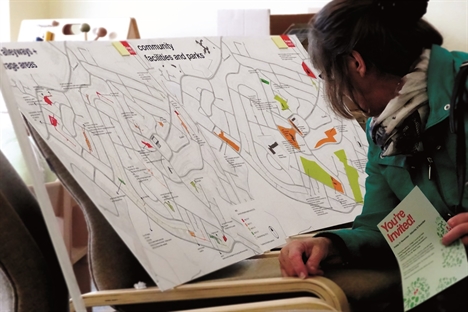
School lessons
During the ‘festival’, project leaders also contacted schools and youth centres to hear what they had to say about the findings and proposals. They ended up “knitted into the overall vision”, Heaton said, with the views of teachers and other staff taken into account. Schools were also told they could have future involvement via apprenticeships and work placements.
There was a specific schools-focused idea to get them to share their sports fields. Heaton explained: “There’s benefits for the schools in terms of bringing the public into school grounds and benefiting from their facilities – and there’s fantastic benefits to the wider public: access to green spaces and sports fields that are well-maintained. That’s the synergy we hope will happen in the future.”
Sue Bickler, the council’s head of regeneration and one of the leaders of the West Howe redevelopment project, said a major consultation over one weekend proved a big success, with lots of engagement and partners involved.
“As a result of that whole process, a series of recommendations were made and a report was put through the generation partnership board, which was approved right at the beginning of this year,” she told us. “We’re now working our way through how we can implement those recommendations, some of which can be done through mainstream delivery, while some are dependent on community members. In the long term, there will be some major projects looking at the potential for redesigning the centre of the area, bringing in some more public facilities and services, and a whole load of recommendations around making the area more walkable, more cyclable, with roads safe to cross and more inspiring open areas of land in terms of physical activity.”
But Heaton guarantees that the work is viable despite now requiring a ‘funding masterplan’: “We brought in a development economist and he evaluated all of our proposals, checking the economic viability of the scheme in the wider market.”
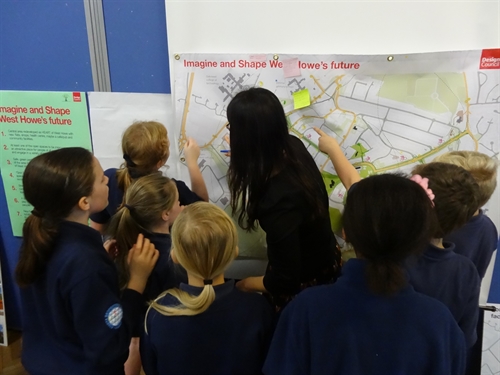
The costs don’t have to be high
The premise of Active by Design is simple: helping communities fill the gaps in public health promotion. And with the recent announcement of £200m of cuts to councils’ public health budgets, it could be needed more than ever.
Design Council experts, who only charge a small fee to carry out walkabouts and assess the health discrepancies of a community, say that forking out large sums of money isn’t always necessary to regenerate a town. Its BEEs have done extensive research into a handful of other shining examples that have stimulated better health by bringing the public sector together – some of which are so popular that they have become self-sustainable.
One notable project, also headed by Heaton, is a growing space for homeless people at the back of London Bridge. The displaced men who occupied the area – a derelict car park at the time – worked with his team to redesign the space and, within two years, began growing herbs and vegetables locally. They now sell their independently grown produce to a local restaurant: a remarkable change from past alcohol and drug misuse.
The charity the Design Council commissioned to run the project, now known as ‘Putting Down Roots’, has now adopted six more projects, each teaching homeless participants gardening, landscaping and building skills.
Heaton said: “It’s all about the health and social benefits of growing food. They even have open nights where they get chefs in to cook meals, and they invite local people and businesses to attend. It’s fantastic to see. All I did was provide a framework, a place with good soil, power and lighting. I designed it, but the local guys who were previously sleeping on park benches built it with their own hands, and now they’re running it. It will go on for years, and they’re making it profitable. The idea was that they would grow carrots that could be smashed into soup and given out at the soup kitchen down the road, but because of the local enthusiasm, it took off.”
Other examples – though significantly more expensive – include sustainable development charity Bioregional, which seeks to tie up the loose ends between public health practitioners and the wider public sector to implement sustainable, energy-efficient measures. The programme focuses on health, local economy, culture, land use, wildlife, zero waste, sustainable food, materials and transport.
Its impressive portfolio includes a joint endeavour with Middlesbrough Council to tackle fuel poverty, make cycling an attractive way to travel, and increase local food growth and improve local habitats for wildlife; a partnership with Oxford City Council and private companies to make green solar electricity connect easily and affordably into local electricity grids; plus an entire eco-village in Brighton.
That development, ‘One Brighton’, which opened in 2009, was accredited as the first ‘one planet community’ in the UK: 172 new homes were built in the country’s largest car-free development. Of the houses, 30% are social rent units and 11% are ‘eco-studios’ for those who don’t qualify for social housing. A linear park connects to transport hubs and green spaces while mini rooftop allotments allow residents to grow their own herbs. Fences have climbing holds to promote free exercise and ample cycle parking stimulates locals to get out and about. The effort, green down to a tee – even the concrete frame was the greenest in the UK – led to a 67% reduction in operational carbon emissions compared to the country’s existing housing stock, with a potential to achieve an 89% reduction by 2020. There are anecdotal reports of improved health and reduced obesity among residents.
Brighton & Hove City Council says it has since incorporated lessons learned from the development into its overall planning policies.
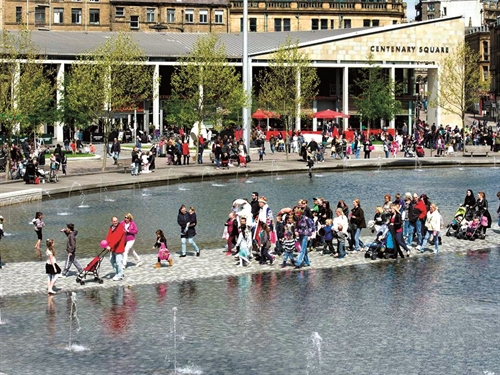 City Park, Bradford
City Park, Bradford
Hidden benefits
City Park in Bradford saw similar urban transformations as part of the borough’s regeneration strategy. The park now features an interactive ‘mirror pool’ at the heart of the city centre that can be drained down to create different water effects – or totally drained to provide a large space for festivals and events. The surrounding ring road lost two of its vehicle lanes to wide pedestrian and cycle crossings stitching the centre together again with the university, National Media Museum and adjoining residential areas. Bradford now sees nearly 150,000 more walking trips to the city centre each year, with children – probably far more than the 21% national average of kids who play outdoors – playing in the prominent interactive water feature.
In fact, interactive add-ons like Bradford’s water feature – including dramatically cheaper options – can be more beneficial than they initially let on. Heaton told us many urban planners are extremely interested in what they can do for a community: “I’m really into the new ideas of making all urban environments ‘playful’, like putting swings at bus stops like they have done in Montreal.
“Also making all street furniture playful, so mums who are shopping can let their children burn off a bit of energy outside while they’re walking around the shop.”
Other interactive features that cost next to nothing and can get youngsters moving are innovative playground structures, such as the successful Camden Active Spaces project. And, if a council has a bit of cash and local talent to spare, interactive piano stairs like the famous one in Stockholm’s Odenplan subway station can be a great way to encourage people to ditch the escalators.
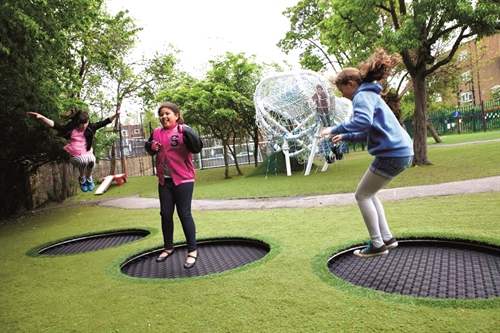 Camden Active Spaces
Camden Active Spaces
Great outcomes
Commending Camden Active Spaces and Bradford’s City Park, Rachel Toms, Active by Design’s project leader, said: “Those two projects show that you can achieve great health outcomes through excellent design. If we use health as a starting point in the projects that we deliver – we as in the construction and regeneration industry – then we will take great steps forward in this field, while also contributing to cities being appealing and prosperous simply because people want to be there.
 “We would like to see health being absolutely mainstream in decision-making in the built environments, and in design and planning,” Toms said. “At the top of the list are highly walkable neighbourhoods: making places like that happen on the ground, making [them] ‘business as usual’ in construction and regeneration, is the ultimate objective – for construction and regeneration industries to really play a part in prevention.
“We would like to see health being absolutely mainstream in decision-making in the built environments, and in design and planning,” Toms said. “At the top of the list are highly walkable neighbourhoods: making places like that happen on the ground, making [them] ‘business as usual’ in construction and regeneration, is the ultimate objective – for construction and regeneration industries to really play a part in prevention.
“Where there’s really a need – where cities are facing growth through housing – that presents a really great opportunity to ‘build’ health into those new neighbourhoods.”
Toms said the principles were applicable anywhere that is “undergoing change”.
Tackling the growing public health challenges faced by most communities can be difficult – and that is exactly when programmes like Active by Design come in. Along with the training sessions they conduct with locals and the enlightening document they put together by the end, they’re also responsible for facilitating the communication between different parts of the public sector that aren’t always in tune. Heaton said that joined-up thinking was in “the nature of strategic planning”.
With rusty bikes collecting dust behind our energy-inefficient houses – and a religious dependency on the car or, at best, nine holy minutes of exercise in our daily trips to the bus stop or train station, it’s no wonder an obesity epidemic is on the horizon. It’s time to act collectively.
Tell us what you think – have your say below or email [email protected]